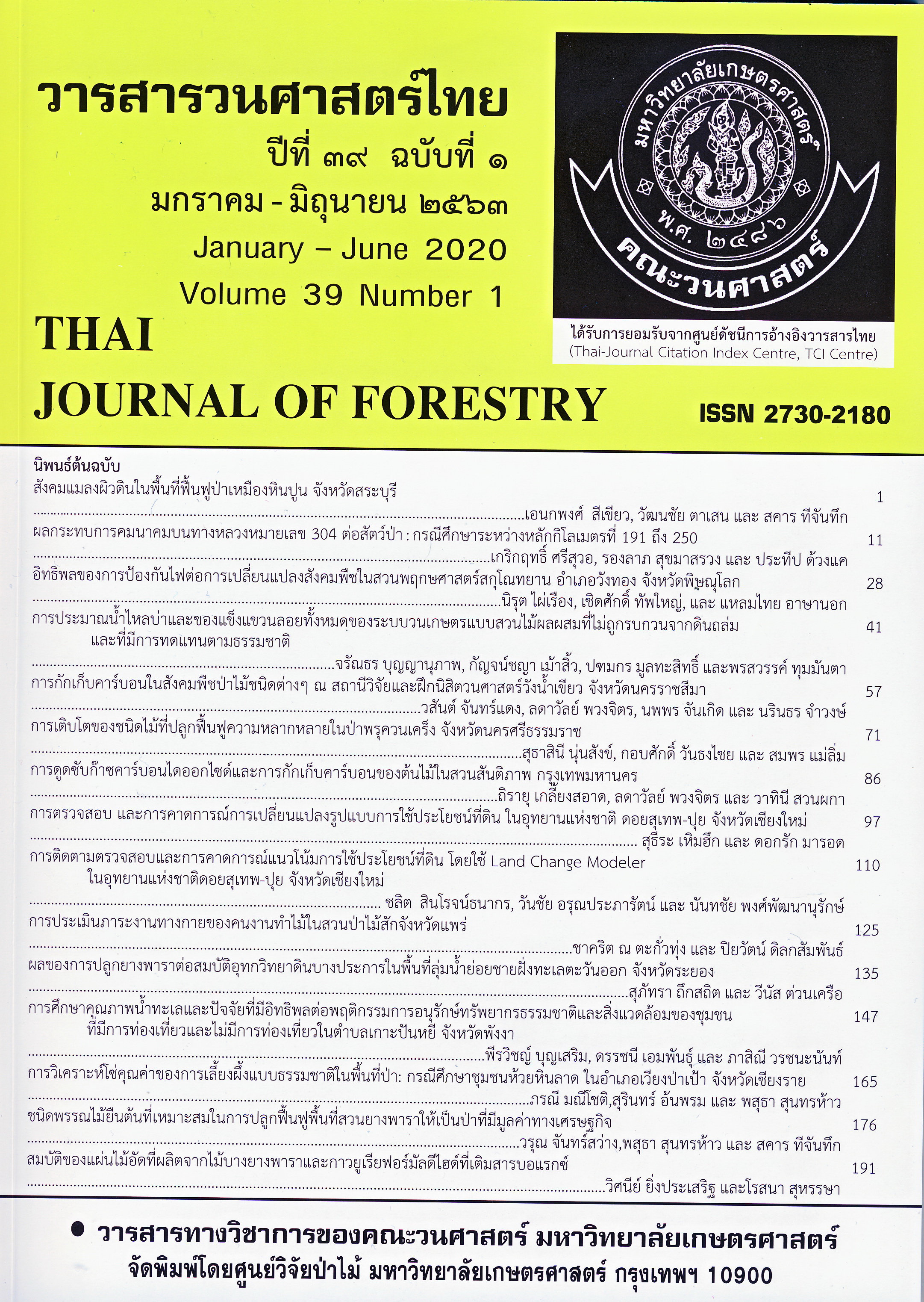การเติบโตของชนิดไม้ที่ปลูกฟื้นฟูความหลากหลายในป่าพรุควนเคร็ง จังหวัดนครศรีธรรมราช
Main Article Content
บทคัดย่อ
วัตถุประสงค์ของการศึกษาครั้งนี้เพื่อศึกษาอัตราการรอดตาย การเติบโตทางด้านความสูง และขนาดเส้นผ่านศูนย์กลางคอรากของพรรณไม้แต่ละชนิดที่ปลูกในรูปแบบแตกต่างกัน ดำเนินการศึกษาในพื้นที่ไม่ถูกไฟไหม้ จำนวน 3 รูปแบบการปลูก ได้แก่ 1) ปลูกแบบยกโคก ในพื้นที่ตัดต้นเสม็ดขาวออกร้อยละ 50 2) ปลูกแบบยกโคก ในพื้นที่ตัดต้นเสม็ดขาวออกร้อยละ 30 3) ปลูกแบบยกโคก ในพื้นที่ตัดต้นเสม็ดขาวออกร้อยละ 10 และพื้นที่ถูกไฟไหม้ จำนวน 4 รูปแบบการปลูก ได้แก่ 1) ปลูกแบบไม่ยกโคก 2) ปลูกแบบยกโคก 3) ปลูกแบบยกโคก และเปิดช่องว่างขนาดเล็ก (รัศมี 2.2 เมตร) และ 4) ปลูกแบบยกโคก และเปิดช่องว่างขนาดใหญ่ (รัศมี 4.6 เมตร) โดยปลูกพรรณไม้ 9 ชนิด สุ่มคละกันทั่วแปลง ระยะปลูก 4x4 เมตร จำนวน 100 ต้นต่อแปลง จากการศึกษาพบว่า อัตราการรอดตายโดยรวม และอัตราการรอดตายแต่ละชนิดพันธุ์ ในแต่ละรูปแบบการปลูก ทั้งในพื้นที่ไม่ถูกไฟไหม้ และในพื้นที่ถูกไฟไหม้ มีความแตกต่างอย่างไม่มีนัยสำคัญทางสถิติ ในส่วนของการเติบโตทางด้านความสูงและเส้นผ่านศูนย์กลางคอรากที่อายุ 2 ปี ทั้งในพื้นที่ไม่ถูกไฟไหม้ และในพื้นที่ถูกไฟไหม้ พบว่า พรรณไม้ส่วนใหญ่เกือบทั้งหมดในแต่ละรูปแบบการปลูก มีความแตกต่างอย่างไม่มีนัยสำคัญทางสถิติ อย่างไรก็ตาม ในพื้นที่ไม่ถูกไฟไหม้ พบว่า ต้นกันเกรามีการเติบโตทางด้านเส้นผ่านศูนย์กลางคอรากแตกต่างอย่างมีนัยสำคัญยิ่งทางสถิติ (p<0.01) ในขณะที่ต้นกรวยแตกต่างอย่างมีนัยสำคัญทางสถิติ (p<0.05) และเมื่อพิจารณาอัตราการเติบโตสัมพัทธ์ทางด้านความสูงและเส้นผ่านศูนย์กลางคอราก พบว่า ต้นแพและต้นตาราแตกต่างอย่างมีนัยสำคัญยิ่งทางสถิติ (p<0.01) โดยที่มีอัตราการเติบโตสัมพัทธ์สูงสุดในการปลูกแบบยกโคกในพื้นที่ตัดต้นเสม็ดขาวออกร้อยละ10 ส่วนในพื้นที่ถูกไฟไหม้ พบว่า ต้นกันเกรา ต้นชะเมาน้ำ และต้นกรวย มีการเติบโตทางด้านความสูงและเส้นผ่านศูนย์กลางคอรากแตกต่างกันอย่างมีนัยสำคัญทางสถิติ (p<0.05) และเมื่อพิจารณาอัตราการเติบโตสัมพัทธ์ พบว่า ต้นแพ ต้นกันเกรา ต้นชะเมาน้ำ และต้นกรวย มีอัตราการเติบโตสัมพัทธ์ทางด้านความสูงและเส้นผ่านศูนย์กลางคอรากแตกต่างกันอย่างมีนัยสำคัญทางสถิติ (p<0.05) โดยที่มีอัตราการเติบโตสัมพัทธ์สูงสุดในการปลูกแบบยกโคก ซึ่งจากผลการศึกษาทั้งหมด พบว่า การปลูกแบบยกโคก พรรณไม้ส่วนใหญ่จะมีอัตราการรอดตาย อัตราการเติบโตด้านความสูง และขนาดเส้นผ่านศูนย์กลางคอรากสูงกว่าการปลูกแบบไม่ยกโคก และการปลูกฟื้นฟูในพื้นที่ไม่ถูกไฟไหม้จะมีอัตราการรอดตายที่สูงกว่าการปลูกในพื้นที่ถูกไฟไหม้
Downloads
Article Details
ข้าพเจ้าและผู้เขียนร่วม (ถ้ามี) ขอรับรองว่า ต้นฉบับที่เสนอมานี้ยังไม่เคยได้รับการตีพิมพ์และไม่ได้อยู่ในระหว่างกระบวนการพิจารณาตีพิมพ์ลงในวารสารหรือสิ่งตีพิมพ์อื่นใด ข้าพเจ้าและผู้เขียนร่วม (ถ้ามี) ยอมรับหลักเกณฑ์และเงื่อนไขการพิจารณาต้นฉบับ ทั้งยินยอมให้กองบรรณาธิการมีสิทธิ์พิจารณาและตรวจแก้ต้นฉบับได้ตามที่เห็นสมควร พร้อมนี้ขอมอบลิขสิทธิ์ผลงานที่ได้รับการตีพิมพ์ให้แก่วารสารวนศาสตร์ คณะวนศาสตร์ มหาวิทยาลัยเกษตรศาสตร์ กรณีมีการฟ้องร้องเรื่องการละเมิดลิขสิทธิ์เกี่ยวกับภาพ กราฟ ข้อความส่วนใดส่วนหนึ่ง หรือ ข้อคิดเห็นที่ปรากฏในผลงาน ให้เป็นความรับผิดชอบของข้าพเจ้าและผู้เขียนร่วม (ถ้ามี) แต่เพียงฝ่ายเดียว และหากข้าพเจ้าและผู้เขียนร่วม (ถ้ามี) ประสงค์ถอนบทความในระหว่างกระบวนการพิจารณาของทางวารสาร ข้าพเจ้าและผู้เขียนร่วม (ถ้ามี) ยินดีรับผิดชอบค่าใช้จ่ายทั้งหมดที่เกิดขึ้นในกระบวนการพิจารณาบทความนั้น”
เอกสารอ้างอิง
Forest Fire Control Division. 2012. Forest Fire Situation at Khuan Kreng in Fiscal Year 2012. Forest Protection and Fire Control Office, Department of National Parks, Wildlife and Plant Conservation. Bangkok. (in Thai)
Forestry Research Center. 2016. Demonstration of Restoration and Restructuring Ecosystems in Khuan Khreng Swamp Forest, Nakhon Si Thammarat Province. Faculty of Forestry, Kasetsart University, Bangkok. (in Thai)
Graham, L.L.B. 2013. Restoration from Within: An Interdisciplinary Methodology for Tropical Peat Swamp Forest Restoration in Indonesia. Ph.D. Thesis, University of Leicester.
Hoffmann, W.A. and H. Poorter. 2002. Avoiding bias in calculations of relative growth rate. Annals of Botany 90(1): 37-42.
Johnson, K.W., T.J. Malterer and C.C. Maly. 1996. Peat-based compost amendment for commercial forest seedling production, pp. 151-161. In Proceedings of the 10th International Peat Congress Vol. 2. 27 May-2 June 1996. Bremen.
Kuerkool, P. 1996. Forest Nursery Techniques. 2nd ed. Royal Forest Department, Bangkok. (in Thai)
Lappalainen, E. 1996. Global peat resources, pp. 80-86. In Proceedings of the 10th International Peat Congress Vol. 2. 27 May-2 June 1996. Bremen.
Nuyim, T. 1995. Peat swamp forest rehabilitation study in Thailand, pp. 125-132. In Annual Conference Report on Forestry for 1994. Royal Forest Department, Bangkok. (in Thai)
Nuyim. 2004. Guideline on Peat Swamp Forests Rehabilitation and Planting in Thailand. Department of National Parks, Wildlife, and Plant Conservation, Bangkok.
Nuyim, C. Nilnond and P. Kaewwongsri. 2002. Effect of mound and unmound on soil environment and growth of some peatswamp plants in deteriorated peat land, pp. 79-103. In Proceedings of the Symposium of 2 Centuries Phikultong. Phikulthong Study and Development Center, Royal Initiative Project, Narathiwat. (in Thai)
Phengklai, C., C. Niyomdham and W. Uejirakarn. 1991. Peat Swamp Forest Plant Species of Narathiwat. Phikulthong Study and Development Center, Royal Initiative Project, Narathiwat. (in Thai)
Phitthayakhachornwut, P., C. Niyomtham, C. Urapiphatthanaphong and T. Sinna. 1994. Manual for Nature’s Study Trails in the Peat Swamp Forest. New Thammada Printing Ltd., Bangkok. (in Thai)
Rusmana, D.R., P.B. Santosa, T.W. Yuwati and L.L.B. Graham. 2014. Response of peat swamp forest species seedlings to light intensity, pp. 2-14. In Tropical Peat Swamp Forest Silviculture in Central Kalimantan. Kalimantan Forests and Climate Partnership, Jakarta.
Schuch, M. and A. Zollner. 1996. Peatland in Bavaria: use and conservation, global peat resources, pp. 107-113. In Proceedings of the 10th International Peat Congress Vol. 2. 27 May-2 June 1996. Bremen.
Sorensen, K.W. 1993. Indonesian peat swamp forests and their role as a carbon sink. Chemosphere 27(6): 1065-1082.
Suzuki, K. and K. Hara. 1995. Ecological rehabilitation of the tropical swamp forest, pp. 17-24. In P. Vijarnsorn, ed. A Tropical Swamp Forest Ecosystem and its Greenhouse Gas Emission. Nodai Research Institute, Tokyo University of Agriculture, Tokyo.
The Chaipattana Foundation. n.d. Soil. Available Source: http://www.chaipat.or.th/publication/publish-document/tips/36-2015-04-03-10-16-17.html, February 24, 2019. (in Thai)
Wanthongchai, K. and P. Sanguantham. 2016. Damage evaluation of Khuan Kreng swamp forest fire in 2012, pp. 168-169. In P. Sunthornhao, ed. 8 Decades of Forestry, the Science of Life. Faculty of Forestry, Kasetsart University, Bangkok. (in Thai)
Yoshino, K., T. Ishida, T. Nagano and Y. Setiawan. 2010. Landcover pattern analysis of tropical peat swamp lands in Southeast Asia, pp. 941-946. In International Archives of the Photogrammetry, Remote Sensing and Spatial Information Science Vol. 38 Part 8. Kyoto, Japan.


